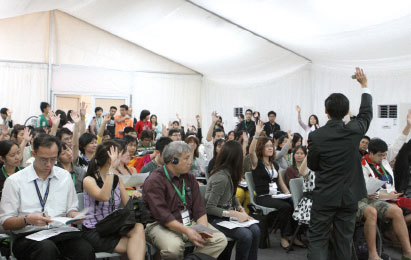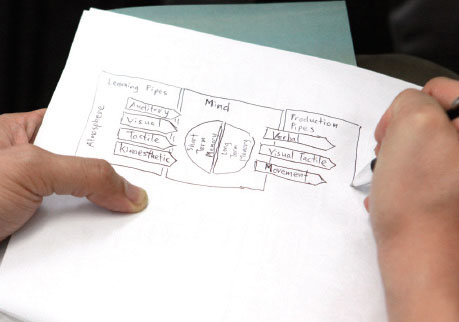Certified learning styles consultant Michael Choy sheds lights on the four main learning styles for children at the CGI-Asia Conference 2010 elective workshop.
 Does your child have difficulty retaining what he has learned in school? Does he/she seem to have a short attention span and tune out whenever you try to teach him new things or correct his mistakes? If so, your child may not be using a learning style that best suits him/her.
Does your child have difficulty retaining what he has learned in school? Does he/she seem to have a short attention span and tune out whenever you try to teach him new things or correct his mistakes? If so, your child may not be using a learning style that best suits him/her.
More than 60 delegates of CGI-AC 2010, who sat through Michael Choy’s one-hour elective workshop on children’s learning styles on May 26, discovered that in order for children to study effectively and to do well in school, they need to adopt the correct learning style that best suits them. Simply put, a learning style is the most effective way in which a person receives, thinks about and remembers new and difficult information.
Choy shared that children absorb information through four main “learning pipes,” namely, Auditory, Visual, Tactile and Kinesthetic. In order for a child to retain information effectively, he/she must use the learning pipe that best suits his/her learning style.
For example, a child who has a visual learning style will retain information more effectively by using mind maps or pasting newspaper articles with important learning points. Conversely, a child who is more inclined toward the kinesthetic learning style remembers movement or action better than words or pictures. Hence, it will be more effective for that child to learn by teaching others, or by getting him or her to research the study topic on his own.
Choy further illustrated his point by explaining what might happen when parents try to give a “lecture” to their children. “If your child’s learning style is not auditory, when you try to teach him, he will go into a ‘screensaver’ mode,” said Choy. Your child will not respond.
How then, does one go about discovering a child’s learning style? One sure way is by observation.
Children who are inclined toward a visual learning style tend to remember pictures and colors better than sound. They are also attracted to video clips and diagrams, and remember what was shown, rather than what was said. A child who is apt at the auditory learning style is likely to need little verbal repetition, and will be able to listen attentively for more than 20 minutes. Conversely, a child that learns best through a tactile style needs to feel things before he can remember them. Such a child will learn better by rewriting key points when studying, and by touching and fiddling with things, in other words, a hands-on, experimental approach in learning
One sure sign of a child with a kinesthetic learning style is that he/she is likely to accompany his/her speech with body or hand gestures, remembering movement better than words.
 |
 |
| CN PHOTOS: Tan Song Kow | |
Adopting the correct learning style is not just important for children, but also for adults. Choy illustrated this with an everyday life example. He brought up a recent sermon message preached by Kong Hee on Jesus’ healing ministry from Matthew 4:24 to 9:35 of the Bible, and challenged the delegates to recall the healing acts Jesus did, such as “healing the masses” or “crossing the lake” and “delivering two men who were demon-possessed.”
Those who simply “saw” the acts flashed on screen found it more difficult to recall the points afterward, whereas those who sketched out the information with their fingers or used hand gestures to remember each of the acts had a much easier time remembering the information. This outcome is not unusual, as the percentage of people who can remember by simply seeing is not usually high.
Choy recommended that parents start using all four modes to inculcate correct moral values into their children from a young age.
“Advanced technological influences such as computer games and movies are using all four modes to win over our children, so as parents, we must teach or correct them using these modes instead of simply scolding them when they do something wrong,” said Choy.
He cited an example of how parents should not simply tell their children about the dangers of giving information to strangers online. They may also consider posting relevant educational articles and videos on their Facebook pages, which may appeal more to their children.
Summing up the workshop session, Choy said that children may be profiled to determine their learning styles from as young as 10 years old. He further emphasized that if the correct learning style could be identified early, any child can grow up to be a genius.
For more information, log on to www.activeintelligence.net.
